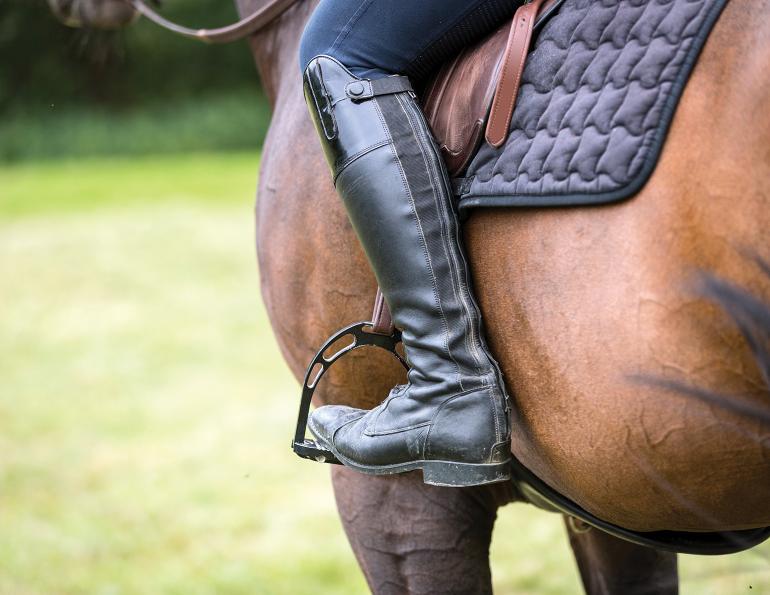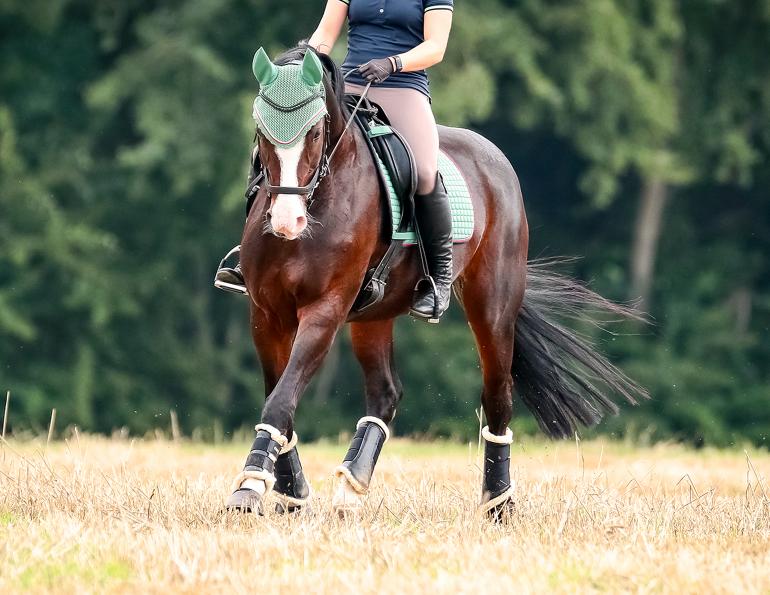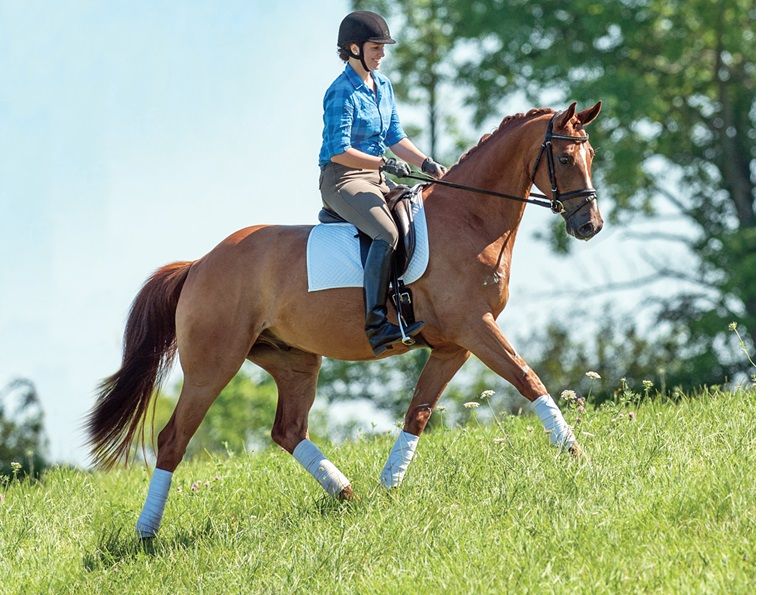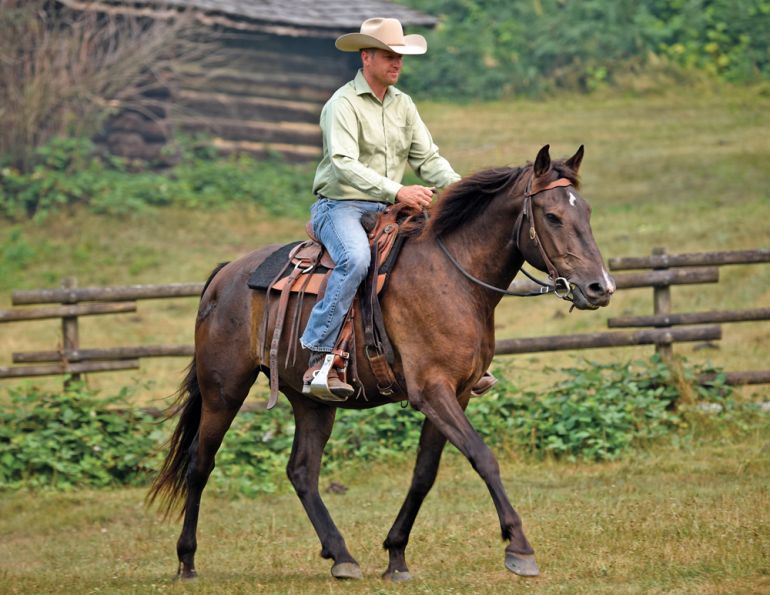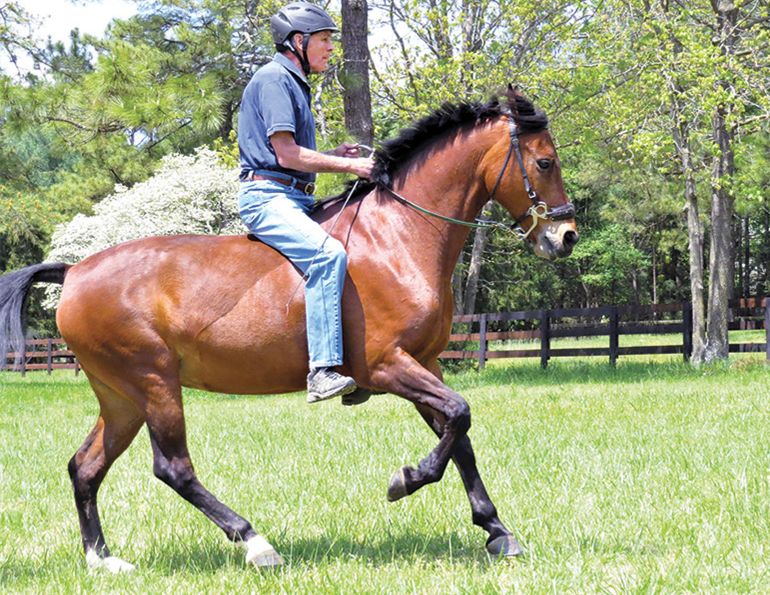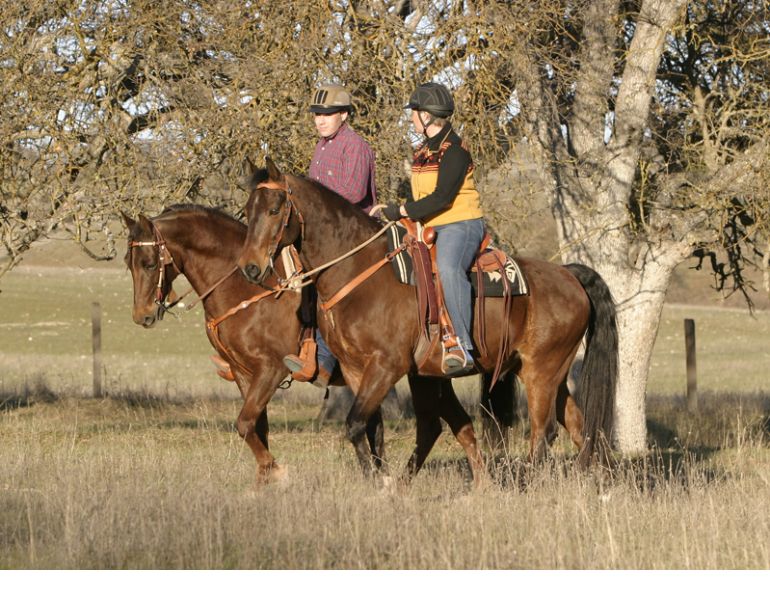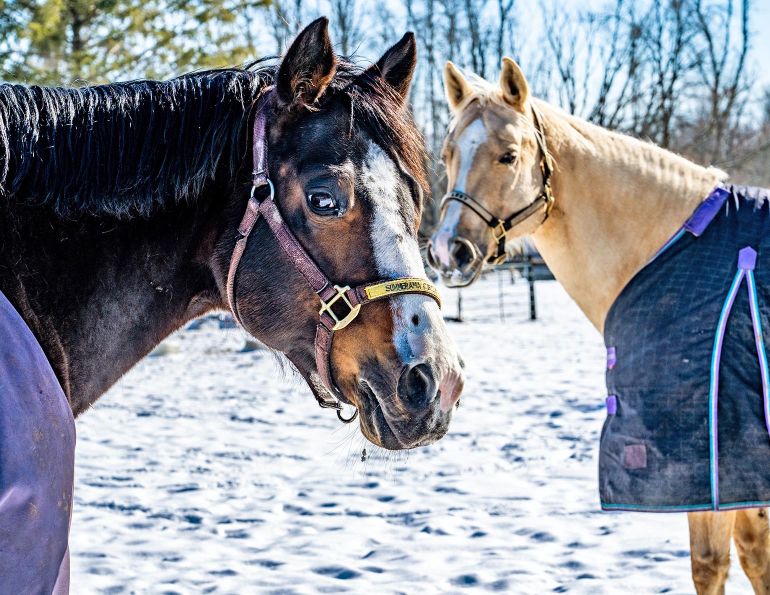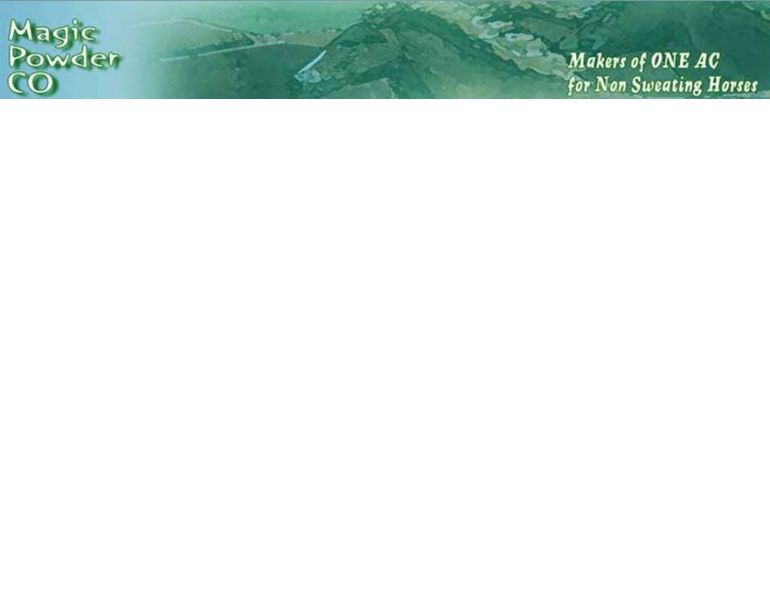By Lindsay Grice, Equestrian Canada coach and judge
Who doesn’t love a horse with a laid-back disposition, the unflappable sort, unfazed by snow skidding off the arena roof? The downside of that laid-back horse is that he’s liable to be laid-back about his rider’s aids, too.
Riding a “light” horse in tune with his rider is like playing a musical instrument — distinct notes administered with a light touch.
It’s no fun when riding becomes an aerobic workout. If you stop working so hard — pumping, pushing, clucking — will your horse quit? If so, who’s doing most of the work?
Determine not to babysit your horse with nagging aids. After all, if a horse can feel a fly on his side, he can feel your leg. Our goal for the dull horse is for him to learn to listen to our whispers.
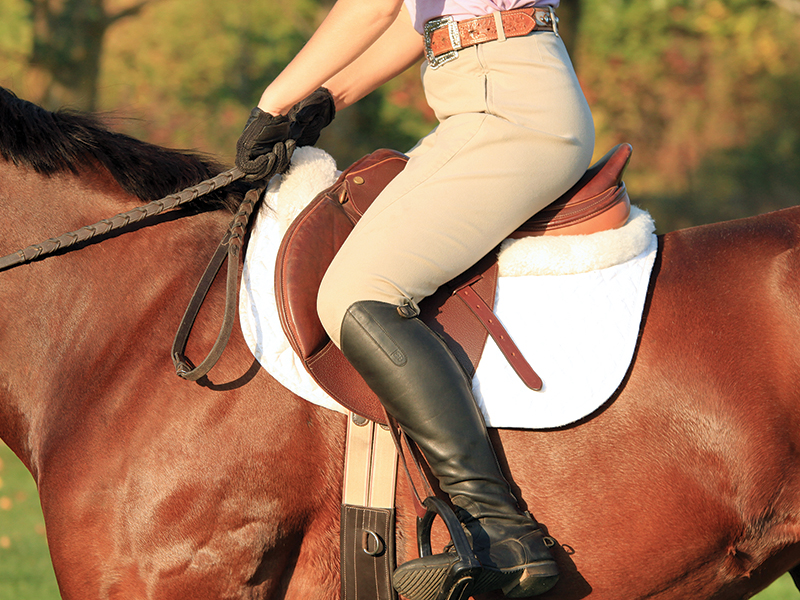
If you stop working so hard — pumping, pushing, clucking — will your horse quit? Photo: Lindsay Grice
Shaping
The shaping process is gradually taking a basic skill and refining it. I coach riders through the following simple progression to resensitize a dull horse to their leg cues:
- The horse is taught the basic go-forward response, to accelerate or lengthen his stride.
- The horse responds from one light, distinct go-forward aid.
- The horse carries himself forward for multiple strides from a single light aid.
Picture your horse within an imaginary box. If your leg represents the back of the box, your laid-back horse has likely become quite content to rest on it as he would on the butt bar of a trailer. When your horse stays inside the box, without you having to hold him there, that’s self-carriage — kind of like cruise control. He’s discovered the box’s boundaries by trial and error, meeting your aids when he makes an unauthorized change. If he loses rhythm, he’ll feel your leg pressure sending him forward again. When a horse is in self-carriage, you don’t have to manufacture the energy — the horse cruises along in rhythm for several strides.
Related: What is Contact? And Do Riders Really Need It?
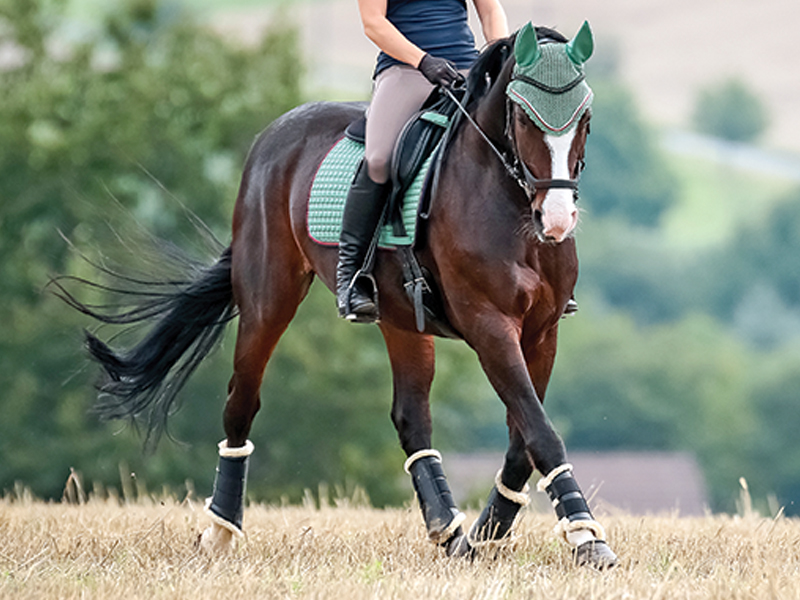
Picture your horse within an imaginary box. When the horse stays within the perimeter of the box without you having to hold him there, he has achieved self-carriage. Photo: Shutterstock/Rolf Dannenberg
The rider’s leg is our focus in this article, but we can’t discount the other sides of the box. A lazy horse tends to zig-zag (particularly when moving away from the barn) or cut to the inside of the ring. With lateral control (the sides of the box) you have the tools to keep your horse on a straight path. Moreover, if your horse is crooked through his body, it’s like having a kink in the hose — energy slows to a trickle. Keep his body parts aligned for the best energy flow.
That energy flow is captured at the front of the box, so that your leg doesn’t send your horse scrambling out the front door with a quicker stride, but rather with a loftier, more energetic one. Impulsion is having more bounce to the ounce — an ingredient lacking in the lazy horse.
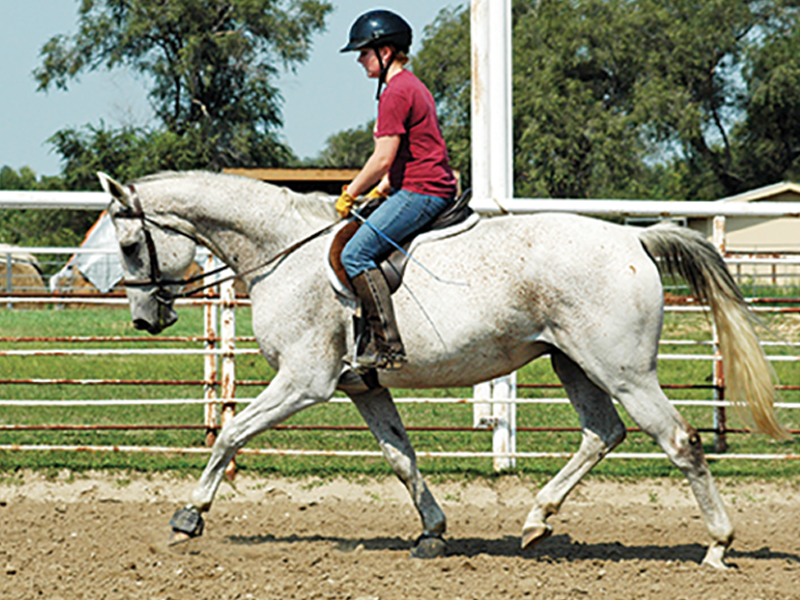
Be determined not to babysit your horse with nagging aids. A horse that is dull to your leg cues can be resensitized to your leg cues and taught to go forward from a single light aid. Photo: Shutterstock/Rolf Dannenberg
Self-carriage is an essential component of a successful ride over fences. Hunter coaches stress the importance of having your horse “in front of your leg” when coming out of a corner to ride down a line. With self-carriage, if the rider has to adjust the horse’s stride on approach to the jump so the horse won’t “fall out the back door,” she will earn a major break-of-gait penalty on the judge’s score card.
For equitation and Western horsemanship competitors, riding a horse with self-carriage can appear effortless. The rider can demonstrate subtle communication, poise, and elegance. Manufacturing energy by goading your horse through a pattern or course never looks elegant.
Related: A Guide to Clicker Training

It’s crucial that your horse consistently finds a sweet spot within the imaginary box. Photo: Lindsay Grice
It’s crucial that the horse consistently finds a sweet spot within the box. Negative reinforcement is taking away (negative) pressure to reward (reinforce) the response we want. What kind of boundaries are you drawing around your horse? Do they waver? We owe it to our horses to clearly define our expectations. Unsteady legs are tricky for your horse to read. Constant pressure or prodding with every post, like white noise, is easy to tune out.
I coach my students to follow this system:
1. Ask - Skilled riders are intentional about their communication. I often ask riders to describe in detail their signal for sending their horse forward. It usually takes several tries before they can spell out the exact location, amount of pressure, and technique. We can’t blame a horse for not responding to a cue he can’t discern or doesn’t understand.
You may need to change your technique. I’ve found that horses are apt to lean on the solid squeeze of a rider’s lower leg, yet will lift off a lighter, pulsing action.
Your lazy horse will lean on the boundaries without sufficient motivation not to. As he habituates to his rider’s aids, the nonchalant horse’s impulsion fizzles, and behaviour problems may emerge. Balking and sullen behaviour goes beyond laid-back to pushback. In my experience, horses are likely to push back against a rider’s assertive squeeze, particularly when moving off from a halt. It makes sense, doesn’t it? Open any conversation with an opinionated assertion and the hearer is inclined to brace against your viewpoint.
When we make our request with the correct technique and amount of motivation, it’s fair to amplify the signal if the horse doesn’t respond.
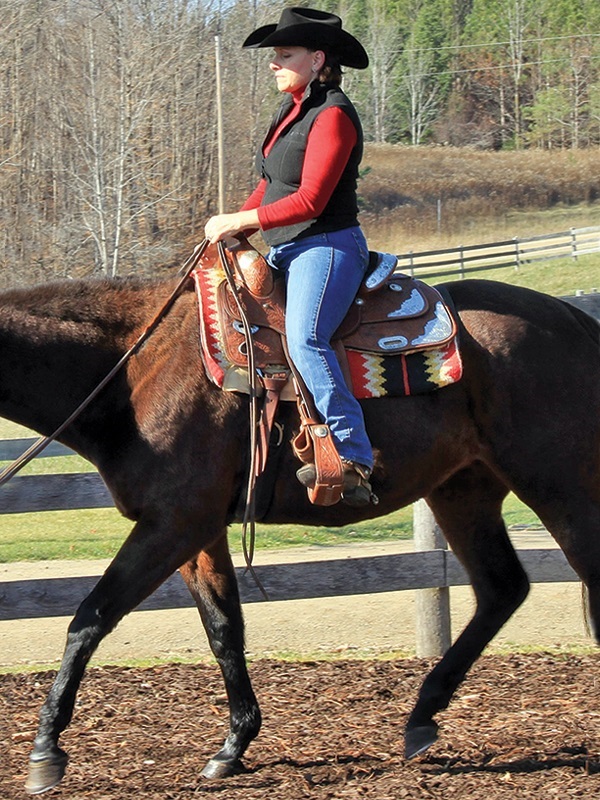
A horse with self-carriage can appear effortless to ride, allowing the rider to demonstrate subtle communication and poise. Photo: Lindsay Grice
2. Escalate — On a scale of one to ten, aim to start each request for more energy at the low end and step it up until you get a reaction without an overreaction. After you’ve given a reasonable light signal, dial up the volume on the megaphone. How fast you go up the scale will depend on your horse’s temperament. Although a sensitive horse requires a careful crescendo, you may have to surprise the dull horse a bit to motivate him. Try a chasing action by lifting up your heel for a couple of sharp little kicks, with a cluck for good measure. Turn up the volume until he surges forward from your leg and reward him the instant he does. Done correctly, after several repetitions of ask and escalate, you’ll be able to refine the process until your signals become more discreet.
To inspire attentiveness to lighter pressures, a rider may choose an artificial aid, used as part of a logical system (light cue, stronger cue, artificial aid, reward). Like an Invisible Fence® for dogs, artificial aids such as spurs and whips amplify the first light signal. Hearing a signal as he approaches the boundary, the dog receives a “static correction” if he connects. Soon, all it takes is the signal to motivate the dog to stay within the perimeter.
Related: How to Find the Perfect Horse Riding Gear

Be determined not to babysit your horse with nagging aids. A horse that is dull to your leg cues can be resensitized to your leg cues and taught to go forward from a single light aid. Photo: Shutterstock/Rolf Dannenberg
Spurs fortify the back or sides of the box, supplying motivation if your “go forward” or “move over” signal is ignored. I wear a spur for most of my riding. By wearing spurs, I won’t miss a training opportunity by being unable to follow through on my request. I simply lift my heel a smidge if I need to deliver just the right amount of authority for on-the-spot motivation.
Will my horse become “reliant” on spurs? Quite the opposite if they’re used in the way I’ve described. Remember, any tool can be abused in the hands of a novice or careless operator. Worn by a rider with reliable control over her lower leg and heel who can avoid accidental kicks or resting on the gas pedal, spurs can help reach just the right spot with just the right amount of motivation.
A whip or crop addresses the back of the box. A whip is used directly behind your leg to follow its cue. Technique is important. Instead of individual wallops, continuous taps are more logical to the horse, but just until he responds. By trial and error, the horse figures out that only acceleration turns off the tapping. Using the whip without affecting the rein in your whip hand takes practice. Choose a whip for schooling that is lightweight enough for you to tap and long enough to reach your horse’s barrel. Remember, using a whip on your horse’s shoulder to amplify your leg will make less sense to him than using it behind your leg.
Remember, our goal is ultimately to use the lightest of natural aid pressures to signal the boundaries of the box.
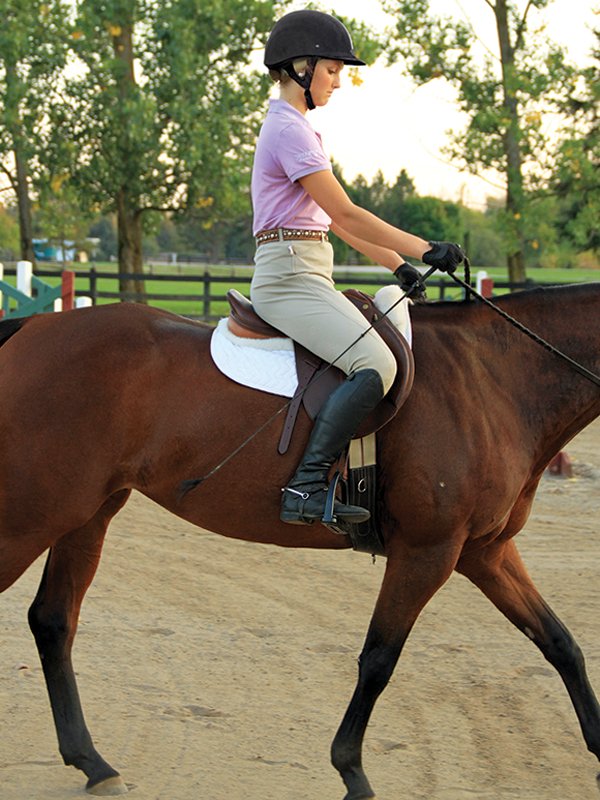
Using the whip correctly without affecting the rein in the whip hand takes practice. The whip should be used directly behind the leg, following the leg cue. Photo: Lindsay Grice
3. Reward - Constant pressure is discouraging to a horse. A rider sabotages impulsion when she pumps her upper body every stride of the canter or squeezes with every down-phase of the posting trot. When the horse’s surge response isn’t reinforced with freedom, he becomes desensitized and stops trying to find the right answer. Instead, catch your horse doing something right and reward it. Timing is everything. For every spurt of energy, immediately lower your heel, softening your leg to send him the “thank you” message. Relax through your joints (hips, elbows, wrists, knees). The box will become a happy place for your horse to carry himself.
Reward with breaks, too. After a few repetitions of surge-forward-on-cue, walk and relax or practice some lower aerobic activities such as turns on forehand or haunches or rein-backs.
Related: What Riding Equipment is Allowed in the Show Ring?
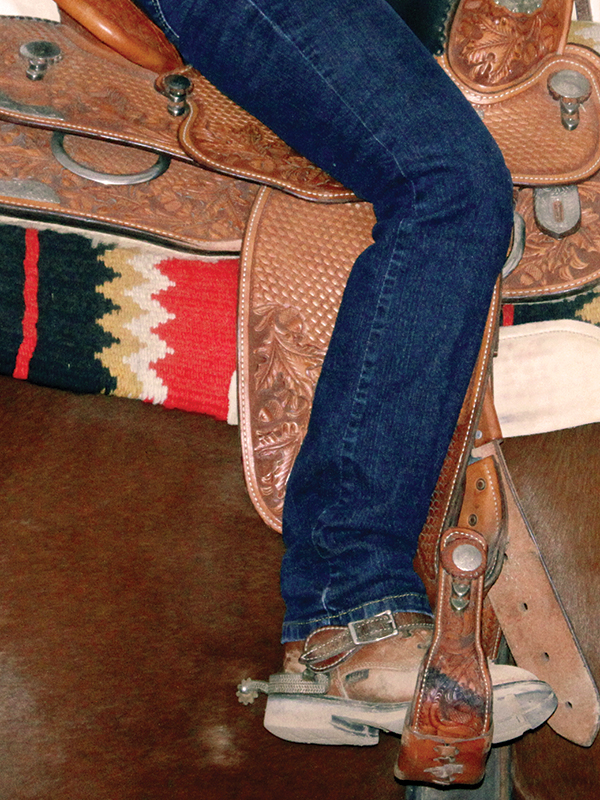
A desensitized horse will always “need” what you’re willing to supply, tuning out anything below that level. Photo: Lindsay Grice
Do you describe your horse as “needing a lot of leg”? A desensitized horse will always need what you’re willing to supply and will tune out anything below that level. Your job is to tune up your tuned-out partner, and that’s when riding your horse will start to feel more like playing a musical instrument and less like a workout!
Related: The Case for Lightness in Horses
Related: The Science of Schooling Horses
Main Photo: iStock/Nullplus



